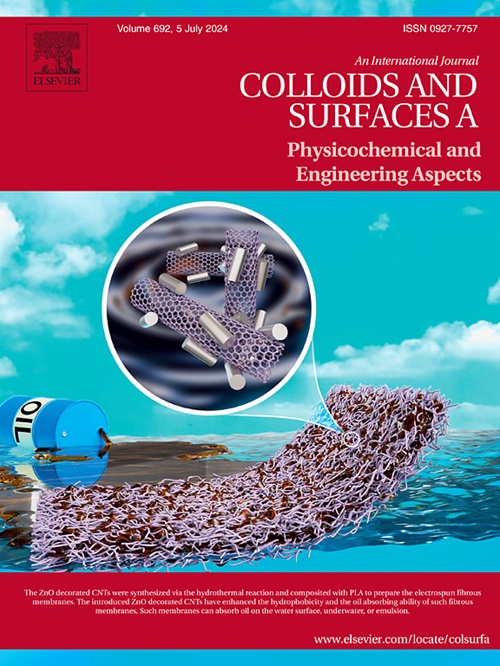掺杂改性SiO2颗粒的聚氨酯气凝胶:具有抗菌性能的先进材料,用于医疗保健应用
IF 4.9
2区 化学
Q2 CHEMISTRY, PHYSICAL
Colloids and Surfaces A: Physicochemical and Engineering Aspects
Pub Date : 2025-05-15
DOI:10.1016/j.colsurfa.2025.137204
引用次数: 0
摘要
医疗保健相关感染(HAIs)是发病率和死亡率的重要原因,通常起源于无生命表面的细菌生物膜。需要具有抗菌性能的新型材料来解决这一问题。本研究探讨了掺杂改性SiO2颗粒的聚氨酯(PU)气凝胶对临床相关革兰氏阳性细菌的抗菌效果。结果表明,与阳性对照相比,掺杂气凝胶可显著降低细菌浓度,金黄色葡萄球菌、表皮葡萄球菌和粪肠球菌的细菌浓度分别降低99.997% %、99.999% %和89.176 %。这种抗菌活性是由于改性sio2颗粒与细菌细胞壁之间的相互作用,这种相互作用可能导致细胞膜不稳定和细胞裂解。这些发现表明,掺入改性sio2颗粒的PU气凝胶可以有效地减少医疗机构中的HAIs。需要进一步的研究来阐明这些材料的确切机理并优化其应用。本文章由计算机程序翻译,如有差异,请以英文原文为准。
Polyurethane aerogels doped with modified SiO2 particles: Advanced materials with antibacterial properties for healthcare applications
Healthcare-associated infections (HAIs) are a significant cause of morbidity and mortality, often originating from bacterial biofilms on inanimate surfaces. Novel materials with antibacterial properties are required to address this problem. This study investigates the antibacterial efficacy of polyurethane (PU) aerogels doped with modified SiO2 particles against clinically relevant Gram-positive bacterial species. The results demonstrate that the doped aerogels significantly reduce bacterial concentrations, achieving reductions of up to 99.997 % for Staphylococcus aureus, 99.999 % for S. epidermidis, and 89.176 % for Enterococcus faecalis compared to the positive control. The antibacterial activity is attributed to the interactions between the modified-SiO2 particles and the bacterial cell walls, which may lead to membrane destabilization and cell lysis. These findings suggest that PU aerogels doped with modified-SiO2 particles could effectively reduce HAIs in healthcare settings. Further research is needed to elucidate the exact mechanisms and optimize the application of these materials.
求助全文
通过发布文献求助,成功后即可免费获取论文全文。
去求助
来源期刊
CiteScore
8.70
自引率
9.60%
发文量
2421
审稿时长
56 days
期刊介绍:
Colloids and Surfaces A: Physicochemical and Engineering Aspects is an international journal devoted to the science underlying applications of colloids and interfacial phenomena.
The journal aims at publishing high quality research papers featuring new materials or new insights into the role of colloid and interface science in (for example) food, energy, minerals processing, pharmaceuticals or the environment.

 求助内容:
求助内容: 应助结果提醒方式:
应助结果提醒方式:


